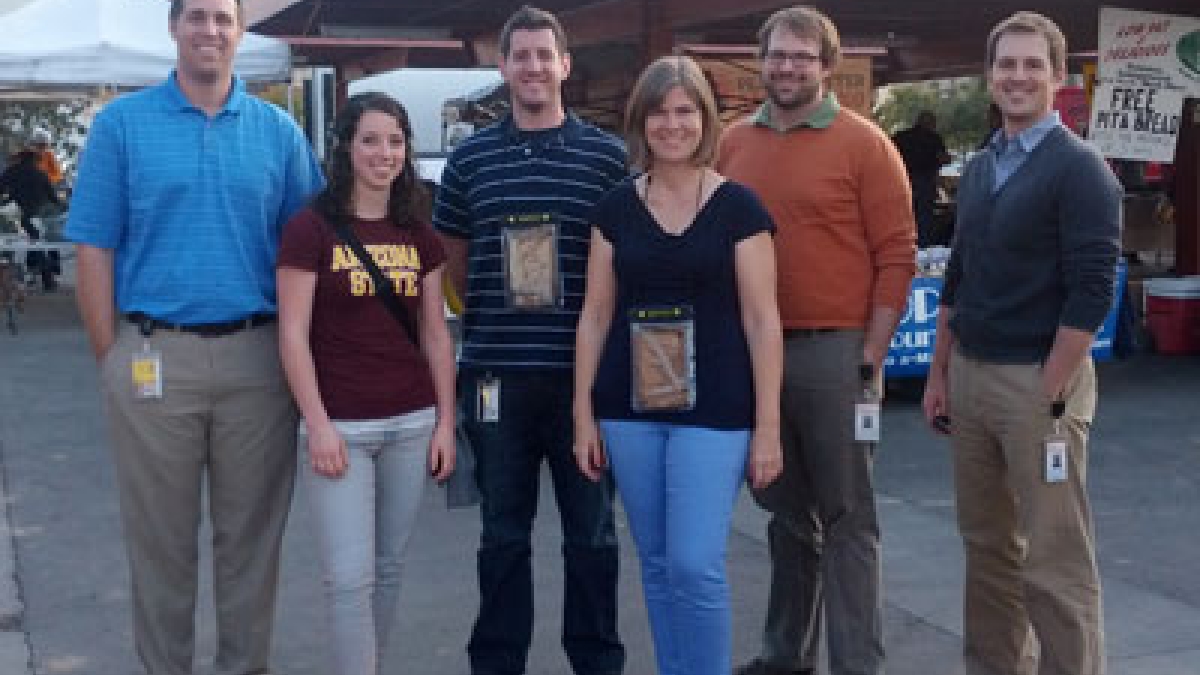Farmers market project wins President's Award for Social Embeddedness

Society’s push for healthier eating habits has produced global trends centered on locally grown food, and farmers markets and their influence among communities have recently skyrocketed.
It was for this reason that Matthew Buman and his team, Farmer’s Markets for Health, decided to research the topic and focus on new age technology and its effects on farmers markets in underserved communities. According to Buman, the Farmer’s Markets for Health team continuously looks at new and innovative ways to promote healthy lifestyles, especially in farmers markets.
“Farmers markets offer a unique opportunity of healthy food options that also serve as social gathering places for communities,” Buman said. “This combination is ideal for reaching communities in ways that are effective in addition to creating environments and promoting behaviors that are health enhancing.”
As part of the Farmer’s Markets for Health research, a team of ASU faculty, staff, students and community partners throughout Arizona and across four different departments completed two projects to identify technology solutions to barriers that preclude use of farmers markets.
Members of the team included Christopher Wharton, Punam Ohri-Vahaspati, and Eric Hekler of the School of Nutrition and Health Promotion’s Nutrition program; Amy Woof of the Exercise and Wellness program; students Farryl Bertmann, Jonathan Kurka, Amanda Gordon, Kristin Fankhauser, and Gina Lacagnina; and community partners Dee Logan, Cindry Gentry, and Art and Heather Babbott.
Buman and his team were awarded the President’s Medal for Social Embeddedness for their hard work – an award which recognizes ASU faculty and staff who have worked as part of a departmental, interdepartmental or transdisciplinary team to demonstrate excellence in embedding the university in the social and cultural fabric of the surrounding community. The award is based on five actions within the community which include community capacity building, teaching and learning, economic development, social development and research. For Buman, the award was much more than recognition of achievement.
The first project addressed the financial barriers of farmers markets by implementing wireless card reader terminals in five farmers markets throughout the state, increasing overall sales and the use of food assistance program benefits. The team also addressed non-finance related barriers by assisting farmers market shoppers in identifying factors that either enhanced or diminished the experience using technology developed at ASU. Although Buman noted that technology itself is not the most interesting part of his work, he disclosed that he is interested in harnessing new technology that can overcome challenges in the field.
“In our case, purchasing goods at farmers markets, especially for low-income individuals relying on supplemental nutrition assistance programs (SNAP), was a major barrier and so it wasn’t so much the technology, but the capability of these new technologies that was intriguing. Also, it was difficult for researchers and market managers to get accurate 'real-time' perceptions from consumers on how they were experiencing the market,” Buman said. “Technology offered unique opportunities to overcome these barriers.”
Buman notes that the hardest part of this project was the difficulty in finding and developing relationships with community partners, but also admitted that this time the process was relatively easy. “We were very fortunate to have willing partners that had real problems we could work together to solve,” he said.
“This award is a true honor for our team. It represents collaboration with community partners at farmers markets around Arizona, and among three programs, two schools and two campuses at ASU.”
Buman believes the project is a testament to the mutual benefit of this type of work to community partners and researchers. “We have found that we can partner together to work on issues where everyone has a crucial role, [where] more can be accomplished and [where] everyone benefits,” Buman said.
Wireless terminals in farmers markets will be a sustained outcome in the future, and Buman and his team plan to publish their results so that other scientists and market managers can benefit from their findings.
Contributed by Shannon Murray